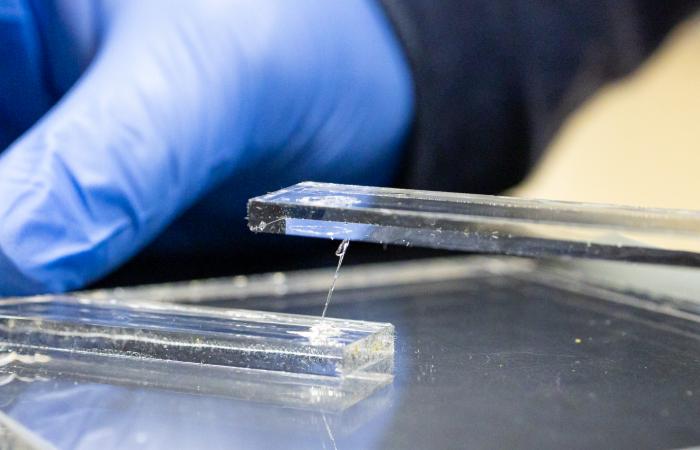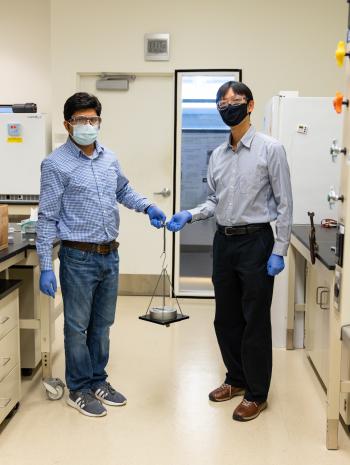ORNL researchers used polymer chemistry to transform a common household plastic into a reusable adhesive with a rare combination of strength and ductility, making it one of the toughest materials ever reported.
ORNL scientists Md Anisur Rahman, Tomonori Saito & team worked to develop this glue.
Researchers at the Department of Energy’s Oak Ridge National Laboratory used polymer chemistry to transform a common household plastic into a reusable adhesive with a rare combination of strength and ductility, making it one of the toughest materials ever reported.

The study, published in Science Advances, fundamentally advances pathways to design a new class of tough adhesives with desirable features merged into a single material. The technology adapts to bear heavy loads, tolerate extreme stress and heat, and reversibly bond to various surfaces including glass, aluminum and steel.
“Strong, tough adhesives are difficult to design because they need to incorporate hard and soft features that are not typically compatible,” said ORNL scientist and corresponding author Tomonori Saito. Structural adhesives such as epoxy are largely designed for load-bearing strength but lack toughness, a property that helps materials dissipate stress when pulled or stretched to prevent sudden failure.
“The challenge has been to add the toughness you get in flexible materials without sacrificing strength. Our approach uses dynamic chemical bonds to develop a novel adhesive with remarkable properties not seen in current materials,” Saito said.
Researchers aimed at upcycling a commodity thermoplastic, polystyrene-b-poly(ethylene-co-butylene)-b-polystyrene, or SEBS, a rubbery polymer material that is easy to process but not engineered for tough adhesion. The goal of upcycling is to add value to common plastics produced in high volume for general and often disposable applications, such as food containers, toys and household items.
The team modified SEBS’ chemical structure with dynamic crosslinking to make it more robust, as well as to create reuse pathways for plastics, beyond traditional recycling, that enhance their performance for new and specialized applications.
Crosslinking is a known strategy for designing materials with more stable properties. The approach can create a bridge between structures that are not normally compatible. In the study, boronic esters were used to couple SEBS with silica nanoparticles, or SiNP, a filler material used to strengthen polymers. The combination yields a novel crosslinked boronic ester-SiNP composite material.
Conventional crosslinking typically results in permanent bonds that prevent adhesives from being removed or reprocessed. The study found that boronic esters enable “dynamic” or reversible crosslinking and are key to the new material’s strong adhesion as well as recyclability. These unique chemical compounds can create stable bonds that can make and break repeatedly – an unusual feature that makes them attractive for sustainable materials design.
“A fundamental discovery was that the boronic esters on SEBS can rearrange bonds with hydroxyl groups – oxygen and hydrogen – on SiNP to adapt properties for demanding jobs. We also found the formation of similar reversible boronic ester bonds with a variety of surfaces that have the hydroxyl groups,” said lead author Md Anisur Rahman, who works with Saito in ORNL’s Chemical Sciences Division.
This two-fold finding was observed experimentally and computationally by density functional theory.
Results showed crosslinked bonds shift within the material to enable specific properties and adhere to surfaces so strongly that a thin square centimeter can hold roughly 300 pounds. Shear tests that measure toughness by trying to detach materials with force were off the charts, widely exceeding all commercial adhesives tested in the study. The material was so tough in adhering to glass, in fact, that glass fractured before the sample debonded. The approach also enhanced thermal stability to 400 degrees Fahrenheit, making the adhesive attractive for ambient and high-temperature applications.
In addition to extraordinary adhesion, a surprising property of the tough material is that it can also be recycled. “It is rare for a high-performance adhesive to be removable, but ours is designed for reuse and recyclability,” Rahman said. “It can be applied and detached with heat and pressure and reused several times.”
The development widens applications for aerospace, automotive and construction adhesives. “There are benefits to industry and the environment to save resources and reduce waste. By design, this adhesive allows you to make repairs or correct costly mistakes and can be reprocessed for new uses in very challenging applications,” Saito said.

The team plans to commercialize the technology and is exploring dynamic crosslinking with other fillers to develop tough adhesives optimized for specific bonding surfaces and functionalities.
The journal article is published as “Design of tough adhesive from commodity thermoplastics through dynamic crosslinking.”
The work was sponsored by ORNL’s Laboratory Directed Research and Development program. Density functional theory calculations were supported by the DOE Office of Science.
UT-Battelle manages ORNL for the Department of Energy’s Office of Science, the single largest supporter of basic research in the physical sciences in the United States. The Office of Science is working to address some of the most pressing challenges of our time. For more information, please visit energy.gov/science.
